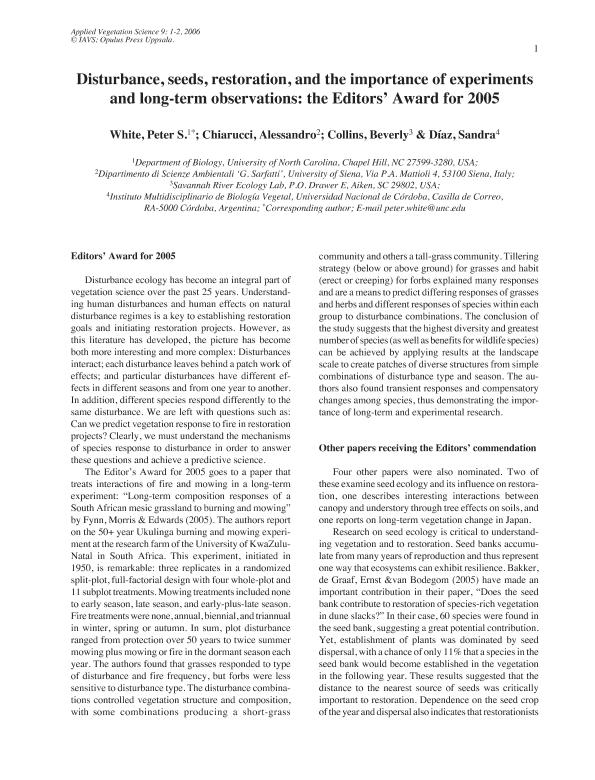Artículo
Editorial article: Disturbance, seeds, restoration, and the importance of experiments and long-term observations: the Editors’ Award for 2005
Fecha de publicación:
05/2006
Editorial:
Wiley Blackwell Publishing, Inc
Revista:
Applied Vegetation Science
ISSN:
1402-2001
e-ISSN:
1654-109X
Idioma:
Inglés
Tipo de recurso:
Artículo publicado
Clasificación temática:
Resumen
Disturbance ecology has become an integral part of vegetation science over the past 25 years. Understanding human disturbances and human effects on natural disturbance regimes is a key to establishing restoration goals and initiating restoration projects. However, as this literature has developed, the picture has become both more interesting and more complex: Disturbances interact; each disturbance leaves behind a patch work of effects; and particular disturbances have different effects in different seasons and from one year to another. In addition, different species respond differently to the same disturbance. We are left with questions such as: Can we predict vegetation response to fire in restoration projects? Clearly, we must understand the mechanisms of species response to disturbance in order to answer these questions and achieve a predictive science. The Editor’s Award for 2005 goes to a paper that treats interactions of fire and mowing in a long-term experiment: “Long-term composition responses of a South African mesic grassland to burning and mowing” by Fynn, Morris & Edwards (2005). The authors report on the 50+ year Ukulinga burning and mowing experiment at the research farm of the University of KwaZuluNatal in South Africa. This experiment, initiated in 1950, is remarkable: three replicates in a randomized split-plot, full-factorial design with four whole-plot and 11 subplot treatments. Mowing treatments included none to early season, late season, and early-plus-late season. Fire treatments were none, annual, biennial, and triannual in winter, spring or autumn. In sum, plot disturbance ranged from protection over 50 years to twice summer mowing plus mowing or fire in the dormant season each year. The authors found that grasses responded to type of disturbance and fire frequency, but forbs were less sensitive to disturbance type. The disturbance combinations controlled vegetation structure and composition, with some combinations producing a short-grass Disturbance, seeds, restoration, and the importance of experiments and long-term observations: the Editors’ Award for 2005 White, Peter S.1*; Chiarucci, Alessandro2; Collins, Beverly3 & Díaz, Sandra4 1Department of Biology, University of North Carolina, Chapel Hill, NC 27599-3280, USA; 2Dipartimento di Scienze Ambientali ‘G. Sarfatti’, University of Siena, Via P.A. Mattioli 4, 53100 Siena, Italy; 3Savannah River Ecology Lab, P.O. Drawer E, Aiken, SC 29802, USA; 4Instituto Multidisciplinario de Biología Vegetal, Universidad Nacional de Córdoba, Casilla de Correo, RA-5000 Córdoba, Argentina; *Corresponding author; E-mail peter.white@unc.edu community and others a tall-grass community. Tillering strategy (below or above ground) for grasses and habit (erect or creeping) for forbs explained many responses and are a means to predict differing responses of grasses and herbs and different responses of species within each group to disturbance combinations. The conclusion of the study suggests that the highest diversity and greatest number of species (as well as benefits for wildlife species) can be achieved by applying results at the landscape scale to create patches of diverse structures from simple combinations of disturbance type and season. The authors also found transient responses and compensatory changes among species, thus demonstrating the importance of long-term and experimental research.
Palabras clave:
Disturbance
,
Vegetation Science
Archivos asociados
Licencia
Identificadores
Colecciones
Articulos(IMBIV)
Articulos de INST.MULTIDISCIPL.DE BIOLOGIA VEGETAL (P)
Articulos de INST.MULTIDISCIPL.DE BIOLOGIA VEGETAL (P)
Citación
Collins, Beverly; Díaz, Sandra Myrna; Chiarucci, Alessandro; White, Peter S.; Editorial article: Disturbance, seeds, restoration, and the importance of experiments and long-term observations: the Editors’ Award for 2005; Wiley Blackwell Publishing, Inc; Applied Vegetation Science; 9; 1; 5-2006; 1-2
Compartir
Altmétricas




